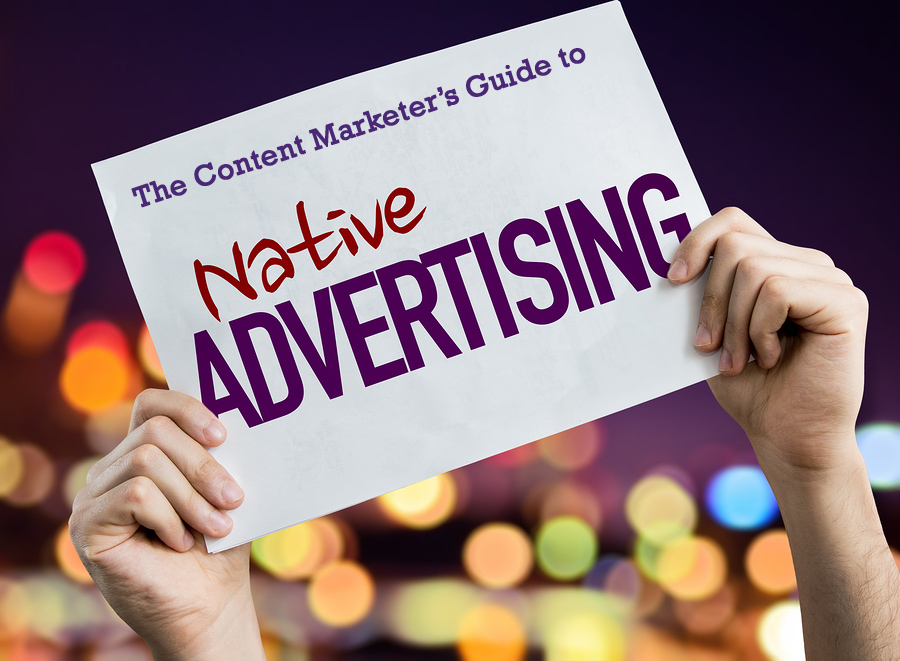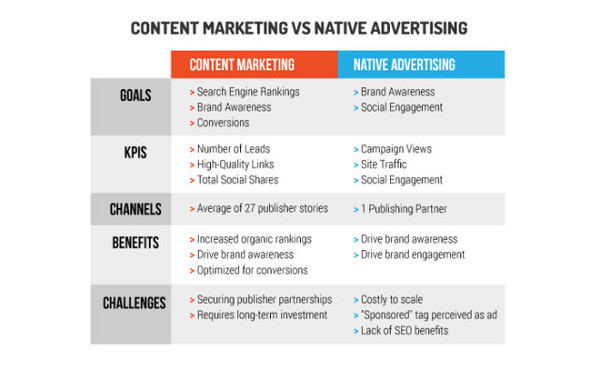In looking for different ways to distribute your content, you may be considering going native – that is, using native advertising as a vehicle for your content.
Admittedly, the concept of native advertising can be somewhat confusing and may even seem a little sketchy as an advertising method. This guide is designed to provide insight on native advertising, warts and all. It will cover such topics as what native advertising is, what the common forms of native advertising are, and how it can be used as part of your content marketing strategy. Additionally, this guide will explore some of the common hits and misses for content marketers employing native advertising as part of their strategy. Let’s get started!
What Native Advertising Is
Native advertising, by simple definition, is a form of paid advertising where the ad experience follows the natural form and function of the user experience in which it is placed.
To break that down a bit, think of it this way. You are likely familiar with the concept of “going native.” This means that a person adopts the cultural traits of people around him or her, in essence blending in with the “natives.”
Similarly, the characteristic that distinguishes native advertising from other advertising forms is that it blends in naturally with its surroundings, thereby eliminating the disruptive nature that characterizes some other forms of advertising like banner ads or pop-ups.
Thus, native ads match the visual design of their surroundings and also behave consistently with the environment in which they are placed.
The Relationship between Native Advertising and Content Marketing
By strict definition, native advertising is paid advertising. Joe Pulizzi, CMI’s content marketing guru, makes this distinction clear in his article “Native Advertising is Not Content Marketing”. He points out that, in content marketing, the brand owns the media. In native advertising, however, brands pay for the placement of content on platforms outside of their own media.
- See Adweek’s comparison of content marketing and native advertising here
Pulizzi asserts that the confusion among some content marketers about the relationship between content marketing and native advertising arises because of the similarities they share. For instance, he notes about native advertising: “The content is useful, interesting, and highly targeted to a specific audience. In all likelihood, it’s not a traditional advertisement directly promoting the company’s product or service.”
That sounds a lot like content marketing. Pulizzi sums it up this way: “If you pay for placement, it’s advertising. If you pay for placement of valuable, relevant content in a format similar to the third-party site, it’s native advertising. If you don’t pay for placement, the content is not advertising. If that content is valuable and relevant, designed to attract a clearly defined audience, and posted on your own or other unpaid platform, it’s content marketing.”
While content marketing is usually targeted to an audience that is subscribed to receive your content, native advertising is paid advertisement that enables you to reach a targeted audience found on other sites.
Types and Forms of Native Advertising
According to IAB’s Native Advertising Playbook, common forms of native advertising include:
- In-feed native ads
- Paid search units
- Recommendation widgets
- Promoted listings
- In-ad (IAB Standard) with Native Element Ads
- Custom Ads
Below are explanations of the different types of native advertising, along with some visual examples courtesy of Venturebeat.com.
In-Feed Native Ads: In-feed native ads fall into three main groups and are generally distinguished by disclosures such as: “Advertisement”, “Promoted by”, “Sponsored by”, “Sponsored Content”, “Presented by”, “Featured Partner”, or “Suggested Post”.
In-feed ads can link to another piece of content on the publisher’s site or to a landing page or piece of content owned by the brand advertising. Some in-feed ads also allow the user to play a video or read content without leaving to a separate page.
In-feed ads are the most common form of native advertising, and are often seen on popular blog sites such as BuzzFeed or Gawker or on social media sites such as Facebook and LinkedIn.

Example of an embedded in-feed ad, Michel Kors.
Paid Search Ads: A common type of paid search ad appears with organic search results, looks like the surrounding results, and links to a page just like the organic search results do. However, unlike organic search results, paid search ads must disclose that they are ads, with wording such as “Ads related to (..)” in their titles. This requirement was initiated by the Federal Trade Commission to ensure that consumers are aware that the content they are viewing is a paid advertisement.
Recommendation Widgets: Just as they sound, recommendation widgets are ads delivered via an inserted widget integrated into a webpage. They are designed to appear based on the context of what a user is reading and searching. These ads do not mimic the appearance of the editorial content feed, but they do integrate with the content therein. They link to a page off the site, and must contain disclosures such as: “You might also like”, “Recommended for You”, and “Elsewhere from around the Web”.
Promoted Listings: Typically found on sites that do not contain editorial content, promoted listings integrate instead with the general browsing experience and are designed to look like products or services offered on a given site. They generally link to a specific product page. Examples include Amazon’s “What’s this?” and “Sponsored Product” links, Yelp’s “Yelp Ad” links, and Google’s “Ad” links.
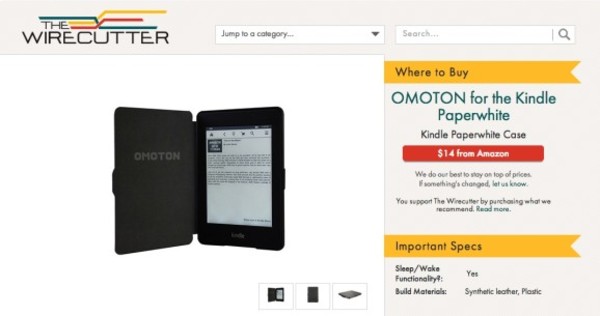
Example of promoted listing, Wirecutter.
In-Ad (IAB Standard) with Native Elements: These ads fit within a standard ad banner but contain relevant information within the context of the article in which they appear. They link to an offsite page. These ads, like other IAB ads, must have clearly defined borders and must contain language which identifies them as advertisements.
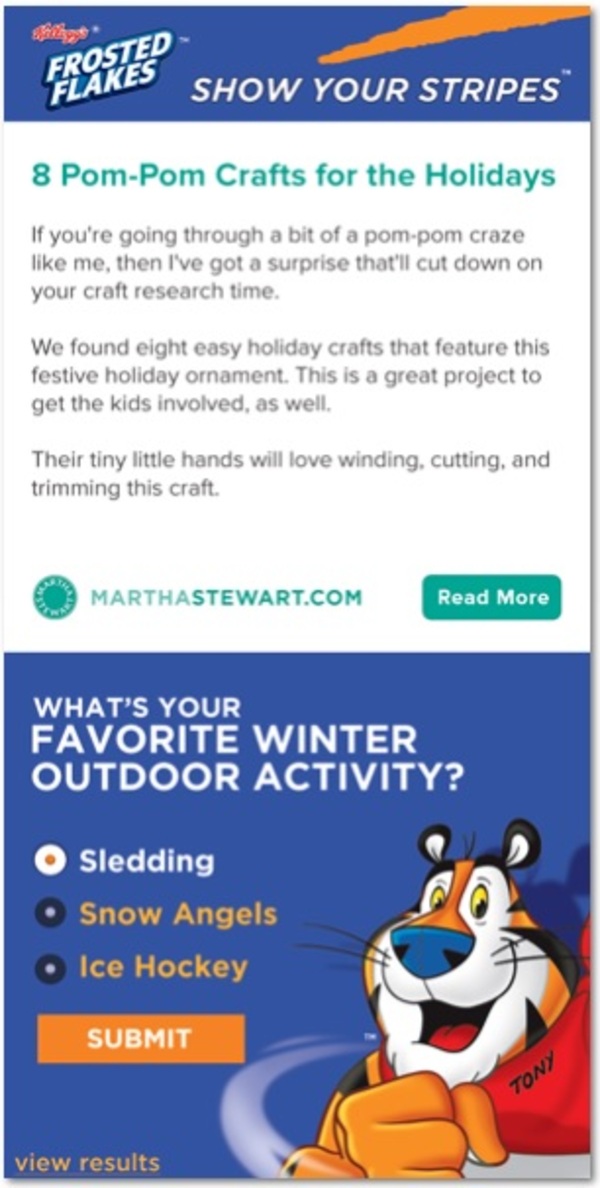
Example of in-ad with native elements, Kellogg.
Custom Units: This general catch-all category of native ads is for all the native ad types that do not fit neatly into the other category types. A defining characteristic of custom ad units is that the advertiser and the publisher work together, customizing content that will be specific to the publisher site.
How to Best Use Native Advertising in Content Marketing
CMI’s “Native Advertising: Fad or New Go-To Standard” predicts: “Native advertising is here to stay. Make no mistake, though. Native advertising won’t displace digital banner advertising nor will it subsume other content marketing initiatives. However, if you view it as another distribution tool in your content marketing arsenal, you may find it has value.”
How can you use native advertising as part of your content marketing strategy? Because native advertising utilizes paid media, content marketers can use it to reach audience members outside of the regular channels used for their content.
Additionally, native advertising can be used to extend the lifecycle of content, breathing new life into old content through directed efforts. Native advertising also supports your retargeting strategies, thus helping you potentially move more prospects toward conversion. Just remember, good native advertising is educational, informative, entertaining, and highly relevant to its target audience. It must also comply with FTC guidelines, which we’ll address in the next section.
Avoiding Potential Problems with Native Advertising
There are a few areas in which native advertisers can stumble badly.
Failure to comply with FTC guidelines: Perhaps the most significant pitfall to avoid when crafting a native advertisement is running afoul of the guidelines as set forth by the Federal Trade Commission concerning native advertising practices.
While it is a good idea to review the FTC’s entirepolicy statement regarding native advertising, the basic principles involved include:
- An advertisement or promotional message should not suggest or imply to consumers that it is anything other than an ad.
- If a native ad is so clearly commercial in nature that it is unlikely to mislead consumers even without a specific disclosure, the FTC does not necessarily require a disclosure be made.
- If, on the other hand, a disclosure is required to prevent deception, the disclosure must be clear and prominent.
The FTC policy statement provides several examples that illustrate how their guidelines should be applied. In addition, the policy statement provides guidance about how to phrase disclosures and where to place disclosures to remain compliant with truth-in-advertising principles.
Ineffective ad placement: Another common pitfall for native advertisers is the incorrect placement of ads. Best native advertising practices involve making wise choices about your publisher and the general placement of your ad.
Native advertising content must be placed with the audience in mind. This means that both the publisher and the brand share a responsibility to always monitor their own native advertising policies and practices to avoid alienating their core audience.
Poor Content Choices: As with any other form of content marketing, native advertising’s success hinges on matching the right message with the right audience at the right time. Whether your native ads are in the form of a promoted Twitter tweet, a sponsored story on Facebook, a featured video on YouTube, or any other native advertising format, the content you provide must be relevant to reap any significant marketing benefit.
Examining the Rise and Effectiveness of Native Advertising
Given these potential pitfalls, you may be wondering if native advertising is worth your time and effort. That is a valid question, and it is one that only you can answer. However, there are significant benefits available to those who follow best native advertising practices.
The Power of Perception: SmallBizTrends.com’s “What Is Native Advertising?” points out that native advertising is designed to address two significant hurdles that marketers face: the fact that consumers have become increasingly weary of traditional advertising techniques and the fact that consumers are also increasingly skeptical about the veracity of advertisements.
Following the theory that perception is paramount in advertising, it is clear that an ad that is perceived to be editorial content is likely to have a more positive impact on the average consumer than an ad that is perceived merely as one more ad in a sea of advertising content.
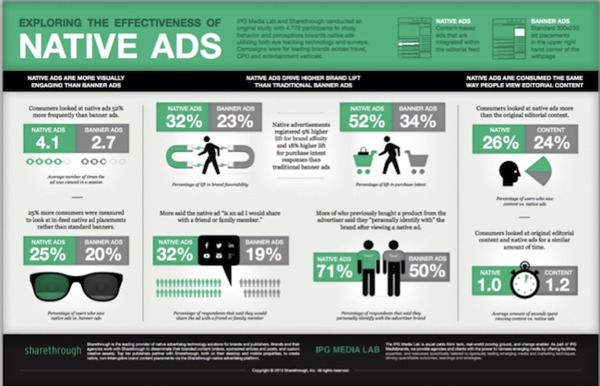
Source: Sharethrough/IPG.
What Neuroscience Reveals about Native Advertising: There is a science behind native advertising that cannot be ignored. Sharethrough, a developer of native advertising company software, commissioned a study from Neilsen to determine how consumers visually process mobile ads.
Nielsen researchers found that native mobile ads receive twice the visual focus that banner ads do. The study notes: “Across native ads and banners, eye gaze appeared to be consistently more concentrated on the native, even though both formats were placed in-feed. Previous studies have demonstrated native’s impact on desktop, where native ads receive 52 percent more visual focus than banners.”
Another Sharethrough studyillustrates the effectiveness of native ads with these statistics:
- Consumers looked at native ads 53 percent more frequently than display ads.
- 25 percent more consumers were measured to look at in-feed native ad placements than display ad units.
- Native ads registered 18 percent higher lift in purchase intent and 9 percent lift for brand affinity responses than banner ads
- 32 percent of respondents said the native ad “is an ad I would share with a friend or family member” versus just 19 percent for display ads.
How Content Marketers View Native Advertising: A recent CMI/Advance OHIO survey reveals some interesting insights about native advertising from content marketers who use the strategy. 43 percent of content marketers surveyed for the study indicate they use native advertising. Almost three out of four have used native advertising for content marketing for less than three years with one-third using it for less than a year.
Of those content marketers who use native advertising:
- 53 percent say it is extremely or very effective
- 90 percent agree that it can be used to build audiences
- 88 percent agree that it can be used to drive an action
- 85 percent agree that it offers valuable content to the reader and can be used to promote content marketing efforts
- 63 percent use it to promote brand awareness
Statistics like this partially explain why spending for native advertising is increasing so rapidly. According to Business Insider, spending on native ads is projected to top $21 billion in 2018, up from just $4.7 billion in 2013.
_600x.jpg)
Source: Business Insider
Exploring the Costs of Native Advertising
The Harvard Business Review article “Comparing the ROI of Content Marketing and Native Advertising” reports on native advertising data compiled by content marketing company Fractl and Moz. The data reveals: “On average, the cost of a native advertising campaign for top-tier news publishers was $54,014.29. (For lower-tier publishers, which we categorized as having a domain authority of less than 80, the cost drops to an average between $70 and $8,000.).”
Digiday’s 2013 article “How Top Publishers Handle ‘Sponsored Content'” also noted that costs vary greatly. For instance, campaigns can range from as little as $5,000 for a post on Business Insider to as much as $100,000 for five posts on BuzzFeed. Falling between those extremes is The Huffington Post, which charges $40,000 for an article, but promotes it on their site for four days.
The HBR article concludes:
“For some firms with large budgets, the expense is worth it if it means aligning their brand with a high-authority publisher and the right niche audience. Ultimately, native advertising has been proven effective in drawing higher click rates than traditional banner ads and other outbound marketing methods, so as a replacement for those, it could make sense.”
Conclusion
Due to its inherent focus on relevance, native advertising is a natural fit for many content marketers. Effective native advertising supplies its viewers with information that matches their interests and needs. In that regard, the focus of native advertising is quite similar to the focus of content marketing.
Content marketers looking to expand the range of their marketing message can reap significant benefits from native advertising if they follow best practices and keep an eye on ROI for their efforts.
Was this native advertising guide helpful? For more information about evolving content marketing strategies and tips and tricks for expanding your content marketing efforts, contact us today.
